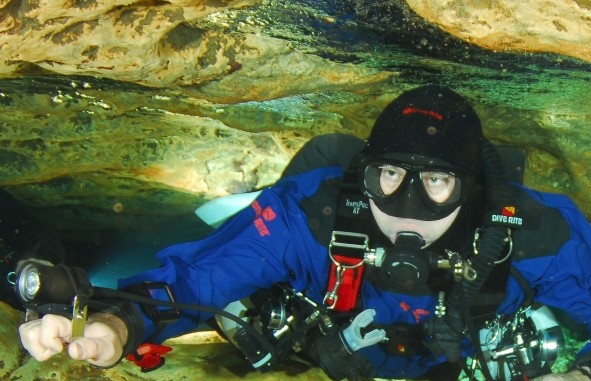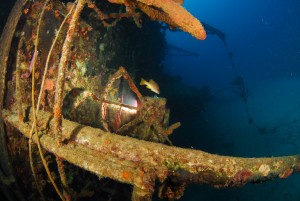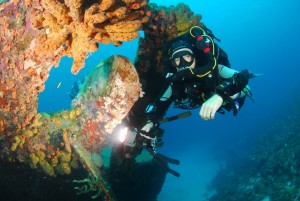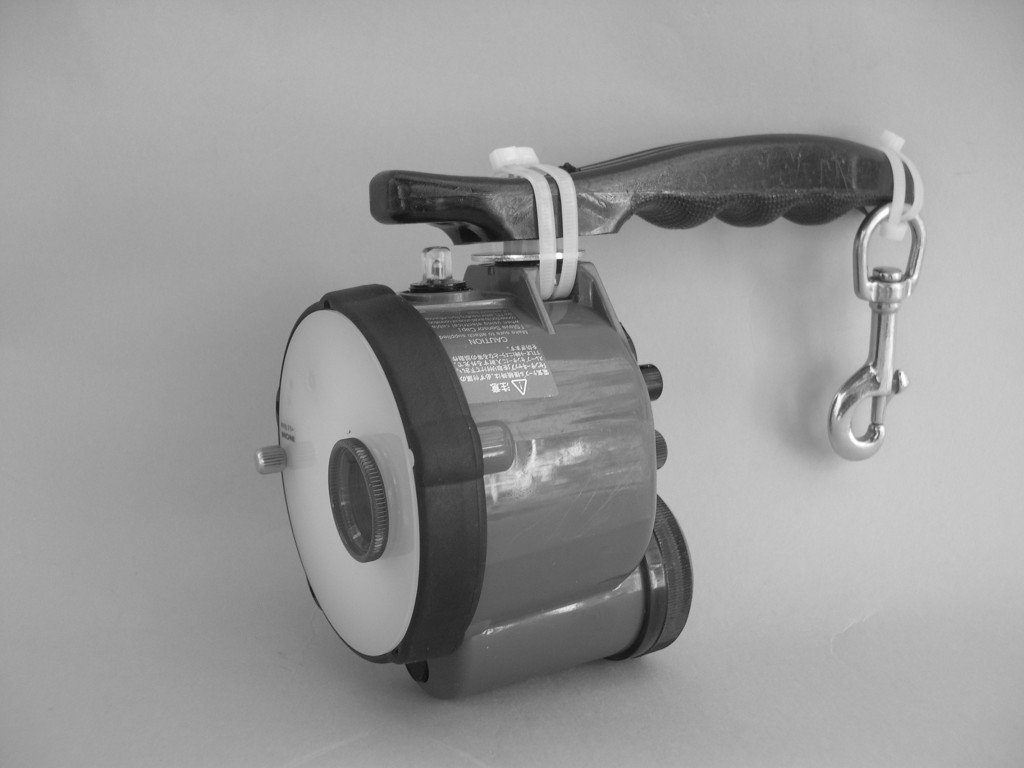News
The Tech Photographer

Many of Today’s divers are engaged in “technical “diving. Simply stated, “any dive in which a diver cannot surface immediately and directly to the surface, is performing a tech dive”. It may be necessary to switch to different breathing mixtures or work with computers that need to have gas changes accomplished during hang times. CCR Divers are always aware and monitoring the PO2 within the loop. These factors increase work load, distractions and can create stress at varying individual levels. Carrying the extra load of double tanks and stage bottles or bail out bottles for CCR divers causes even more drag. Now add a camera into the whole mix. Before you decide just to “grab and go” do not bring a camera into any situation that you have not encountered before; plan your dive carefully.
Carrying a camera can be considered task loading on just about any dive. Why? It’s simple. The diver has just lost the use of one hand. Access to all equipment will have to be accomplished without damaging that expensive piece of photo gear. It may be necessary to cut or remove a piece of monofiliment. It is simple enough to do when both hands are free; however, if the cutting shears are placed where only your right hand can reach them and the camera is now occupying this hand? How do you cut the line in a ripping current when the left hand is now holding you in position? What do you do? Consider reconfiguring your equipment, and packing a second cutting tool.
Photographers occasionally, however improperly, disregard their planned dive profile or run low on air/gas. The following statements are commonly used for justification. “I had to hang because I wanted the shot and had to wait for the right conditions,” or “ I wasn’t paying enough attention to my air supply because I was to busy taking pictures.” Photography is never an excuse to disregard proper dive safety protocols. Buoyancy control is very important not only for reducing the possibility of silting out the photo but also energy and environmental conservation. A diver that is neutrally buoyant expends less energy and reduces gas consumption. The following areas are just two of the many “tech” situations that a photographer may encounter:
Cave Diving
Diving and exploring the subterranean world of an underwater cave takes special training, skills and equipment. An adequate gas supply or appropriate bailout for CCR divers, backup lights and the necessary reels needed to safely navigate this environment quickly take up all available body space. One hand will be occupied with the primary dive light and the second hand may be needed to pull through a strong current. An inefficient fin technique will only tire the diver, so where does the camera go? First of all, the camera should be left behind until this area has been dived by the photographer beforehand (exploration divers are of a different skill set and take years of preparation). Strobe lighting is essential and multiple strobes are considered standard. Is the cave opening large enough? Sidemount explorers may have to change their approach in order to get the diver and camera through a two-foot wide crack in the earth!
Following a dive plan that has been agreed to will be required if the photographer expects results. After the site has been chosen and a decision made on what subject will be photographed, the divers will have to get into the cave. High flow areas may require modifying techniques. One technique is to allow the diver without the camera to lead the dive. The lead diver can actually deflect part of the strong flow. The photographer will have to stay close behind to take advantage of the flow deflection. An errant kick however can be devastating to a camera system. The photographer will not only have to protect the camera from his dive buddy but maneuver in such a way as to avoid slamming it into the bottom or the cave walls. Once inside it will be necessary to swim with a light and camera system at the same time. Attaching a primary light to the camera system is one technique or using a “Goodman style handle” on the light will allow the diver to hold the camera and light at the same time. Navigating through very tight areas may require reconfiguring equipment and thinking. Sidemount diving has gained much attention of late. In this situation the tanks are moved from the divers back and are mounted along side the body. Air management is even more critical since the entire air supply is not accessible from one regulator. This type of diving will require multiple regulator exchanges during the dive. This configuration should not be attempted without proper training and practice. Placement of camera lanyards must not interfere with regulator access. In this case it may be best to dispense with any lanyard to avoid entanglement with regulator hoses. Multiple strobe systems may not work in tight areas because the strobe arms cannot be extended properly. Large flexible arms may be small enough to negotiate cramped passages. As simple detachable strobe arm system may be a better choice. It is important to have a pre-dive briefing explaining when and how the photo is to be attempted. You may wish to have your buddy carry and position the secondary slave strobe in order to achieve results in tight places. Practice the photo in a simple situation first. Local quarries have easily accessed areas, such as school buses. This will allow planning and practice in a low stress environment. Most digital strobes have sensors that will pick up the primary strobe flash. However it may be necessary to add a sensor cord to help the strobe “see” the primary flash.
Many divers are using Nitrox as a breathing medium and a second gas with a higher percentage of oxygen to assist in decompression. Cave divers leave “deco” bottles at the cave entrance where decompression stops will be done. Some buddy teams work with the photographer allowing his buddy to carry his/her deco gas into the cave while they manage the camera system. It is the photographers’ responsibility to ensure their deco bottle is placed properly and secured.
Wreck Diving
Exploring shipwrecks in deeper water for longer periods of time has become commonplace for the advanced wreck fraternity. Cold-water explorers already know how thick gloves hinder movement and dexterity. Many divers find themselves needing deco stops that will require maintaining proper depth in current or wave action, occasionally both, unlike cave divers that more often than not put a camera down and free up both hands. Wreck divers will be hanging in open water and may have to stay close to or hold onto the anchor line while maintaining neutral buoyancy. Wrist lanyards can be uncomfortable because of the extra weight and drag on the arm. This can be fatiguing and can interfere with gear management. Computers that require manual changes may be difficult to work with unless the camera system is “clipped” off and allows the use of both hands. Accessing a second regulator with one hand holding the anchor line and a camera interfering with the other can turn into a nightmare. CCR divers have a whole set of protocols that require diligence and dexterity. Remember in this situation, neutral buoyancy will be important to maintain a consistent depth for decompression. Having the camera clipped off to a separate ring and a lanyard long enough not to interfere with other equipment is the best solution. Lanyard length is determined while the diver is in the prone horizontal position. Wrist mounted computers tend to work the best, and having the ability to have both hands free on occasion will make the dive more enjoyable.
Selecting the type of camera system that will work for the planned dives are just as important. Housed systems are bulkier to work with in the water and create more drag, therefore more fatigue. Aluminum housings tend to have deeper working ranges than plastic housings. It is best to check with the manufacturer for the maximum working depth of the equipment. Although the camera system may be rated to 200 feet it may impossible to use the housing effectively past 150 feet. Extreme temperature changes can cause fogging inside the housing. The use of a desiccant will alleviate the problem. The attachment clip should be of a style that can be released with one hand and is different that any other clip. After surfacing it would be best to hand the camera system up to someone on the boat.
Working with multiple strobes is not as difficult as it appears. Here are a few tips:
- Exposure is based on the strongest light source. The strobes on the camera will illuminate objects closest to the camera. Slave strobes are considered fill lighting.
- Do not allow the slave strobe to point directly into the camera lens. The bright direct flash at close range WILL affect exposure.
- Provide some type of a handle for your dive buddy to work with, and some type of clip. A strobe handle works but a dedicated handle works best.
- Bright sunlight will affect the slave sensors ability to “see” the primary strobe. Therefore it may require practice in positioning in shallow water.
- Pre-plan the dive but allow for critical thinking. This is a three dimensional dynamic environment; things change.
- Bring a slate and use it! This will save time and make communication clear and quick.
This probably sounds like a lot of work……well, it is! This is the reason that any dive of this nature should be planned out and discussed beforehand. If you don’t know the dive or the gear, leave the camera behind. Work as a team to achieve the best results!
Gear News
Introducing the TR-80, IR-50 and CS-30 Regulators from DYNAMICNORD

Whether you are a beginner or a professional diver – with the three new main regulators from DYNAMICNORD, everyone will find their favourite regulator. They all look super stylish.
Excellent performance with the TR-80
Quality and performance are the be-all and end-all for regulators. It is not for nothing that the TR stands for Tec Reg. The innovative design of the TR-80 guarantees absolute reliability – even in ice-cold waters.

Perfect breathing effort at 0.8 J/l / certified for diving in waters below 10 degrees / structural design made of solid brass for best cold protection / membrane-compensated design with dry seal of the first stage / reduced exhalation effort thanks to optimized exhalation membrane and bubble deflector / adjustable Venturi (dive/predive) and adjustment knob for individual inhalation comfort / innovative design of the front cover prevents free-flow in strong currents or when diving with scooters / design made of sandblasted brass, matt chrome finish / 2 HP and 4 LP outlets / mouthpiece made of high-quality, anti-allergic silicone for maximum comfort.


Amazing underwater adventures with the IR-50
The IR-50 is the top regulator for advanced and experienced divers. Natural breathing is the essence of this regulator.

Ideal breathing effort at 0.8 J/l /certified for diving in waters below 10 degrees / compensated membrane / adjustable venturi (dive/predive) and adjustment knob for individual inhalation comfort/ outlet valve and deflector for minimum exhalation effort and reduction of bubbles on the face / design made of sandblasted brass, matt chrome finish / 2 HP and 4 NP outlets / mouthpiece made of high-quality, anti-allergic silicone for maximum comfort.


The Workhorse – our CS-30
For diving centres and diving beginners – the workhorse stands for strong construction, reliability and robustness. Perfect for your training.

Optimal breathing effort at 0.8 J/l /recommended for diving in waters above 10 degrees / non-compensated piston / adjustable venturi (dive/predive) / outlet valve and deflector for minimum exhalation effort and reduction of bubbles on the face / design made of sandblasted brass, matt chrome finish / 1 HP and 3 NP outlets / mouthpiece made of high-quality, anti-allergic silicone for maximum comfort.


Octopus OP-30
The OP-30 is the ideal addition to all DYNAMICNORD regulators. It is identical in construction to the CS-30.

The TR-80, IR-50, CS-30 (DIN & INT) regulators and the Octopus OP-30 are available from DYNAMICNORD dealers and in the online store.
DYNAMICNORD – Your Outdoor Companion.
Marine Life & Conservation
Paul Watson Released as Denmark Blocks Japan’s Extradition Bid

Renowned anti-whaling activist Paul Watson has been released from custody in Greenland after spending five months in detention. Denmark’s Justice Ministry rejected Japan’s request for his extradition, citing insufficient guarantees that his time already served in custody would be credited against any potential sentence.
The 74-year-old Canadian-American was arrested on July 21 in Nuuk, Greenland’s capital, when his ship docked to refuel. His arrest was based on a 2012 Japanese warrant related to a 2010 encounter in Antarctic waters. Japan alleged Watson obstructed operations and caused damage to a whaling research ship during efforts to disrupt illegal whaling. Watson has consistently denied these claims, maintaining his commitment to marine conservation.
Denmark, which oversees extradition matters for Greenland, concluded that while the legal conditions for extradition were met, the lack of assurances from Japan regarding time-served credit made extradition untenable.
In a video shared by his foundation, Watson expressed gratitude and relief, saying, “After five months, it’s good to be out… and good to know they’re not sending me to Japan.” He added that the most difficult part of his time in custody was being separated from his two young sons.
Watson is a pioneering figure in marine conservation, known for founding the Captain Paul Watson Foundation in 2022 after decades of activism with the Sea Shepherd Conservation Society. His bold efforts to defend marine life have earned him widespread support, including from celebrities and conservationists. His work has also been featured in the acclaimed reality TV series Whale Wars.
Watson’s lawyer, Jonas Christoffersen, praised the decision, stating, “We are happy and relieved that Paul Watson is now free.” He added that Watson is eager to reunite with his family and continue his vital work.
The arrest occurred while Watson’s vessel, the M/Y John Paul DeJoria, was en route to the North Pacific with a team of 26 volunteers to intercept a Japanese whaling ship. His foundation described the arrest as politically motivated and emphasized that Watson’s actions were focused on ending illegal whaling practices.
Japan resumed commercial whaling in 2019 after leaving the International Whaling Commission, asserting that whale meat is a cultural tradition. Conservationists, however, continue to challenge these practices, highlighting their impact on marine ecosystems.
Despite the challenges, Watson remains steadfast in his mission to protect marine life and bring attention to whaling practices. His dedication to ocean conservation has made him a globally respected advocate for the environment.
-

 News2 months ago
News2 months agoIconic SS United States to become the World’s Largest Artificial Reef
-

 News3 months ago
News3 months agoBook Review – 52 Assignments: Underwater Photography
-

 Gear News3 months ago
Gear News3 months agoDYNAMICNORD – New German diving brand enters the British market
-

 News3 months ago
News3 months agoExploring Cenote El Pit: A Diver’s Dream
-

 Gear News3 months ago
Gear News3 months agoTry BARE drysuits (and maybe even win one!) this Friday with Sea & Sea at North West Dive Fest
-

 Marine Life & Conservation3 months ago
Marine Life & Conservation3 months agoBook Review: Coral Triangle Cameos
-

 Blogs2 months ago
Blogs2 months agoDive the Egyptian Red Sea this Autumn with Regaldive
-

 News3 months ago
News3 months ago2024 Ocean Art Underwater Photo Competition Announced


















